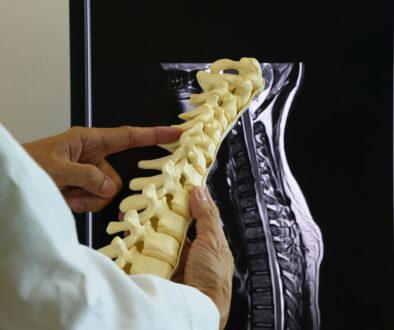Ankle Surgery: When Is It Necessary?
Our ankles are remarkable structures that provide us with stability, mobility, and balance. However, there are instances when ankle problems arise that cannot be effectively managed with conservative treatments alone. In such cases, ankle surgery might be recommended to alleviate pain, restore function, and improve overall quality of life. Dr. David Beck with CMC Orthopaedics is explaining some of the situations in which ankle surgery becomes necessary, the common conditions that might require surgery, the types of ankle surgeries available, and the recovery process.
When is Ankle Surgery Necessary?
Ankle surgery is typically considered when conservative treatments, such as rest, physical therapy, medication, and immobilization, fail to provide relief from chronic pain, instability, or functional limitations. “The decision to undergo ankle surgery is a thoughtful one,” explains Dr. Beck. “We are going to treat you with conservative measures like physical therapy, braces, and more first and foremost before considering the operating room. If those don’t work and after a thorough evaluation of your medical history, the severity of your condition, your lifestyle and regular activities, we’ll consider the potential benefits of surgery.”
Common Conditions Requiring Ankle Surgery
“Our feet and ankles take a beating every day,” says Dr. Beck. “They support our entire body and bear the impact of that weight, so it’s no wonder that they can deteriorate over time and are easily injured from a simple misstep, our activities, athletics, jumping, twisting, or even from wearing ill-fitting shoes.”
Some common conditions that can result in ankle surgery are:
- Ankle Fractures: Severe fractures, especially those that involve displacement or multiple breaks in the bones of the ankle, may require surgical intervention to realign the bones and promote proper healing.
- Chronic Ankle Instability: Recurrent ankle sprains or injuries that lead to chronic instability can necessitate surgical procedures to repair or reconstruct damaged ligaments and tendons.
- Tendon Tears: Complete tears or severe damage to the Achilles tendon or other ankle tendons might require surgical repair to restore normal function.
- Arthritis: Advanced ankle arthritis can cause pain, stiffness, and reduced mobility. Surgical options may include ankle fusion (arthrodesis) or ankle replacement (arthroplasty) to relieve pain and improve joint function.
- Osteochondral Lesions: When there are defects in the cartilage and underlying bone of the ankle joint, surgical procedures like microfracture, drilling, or mosaicplasty can help stimulate new cartilage growth and improve joint health.
We’re Here for You!
A Better Life is a Click Away.
Types of Ankle Surgeries
Dr. Beck stresses that persistent ankle pain is something that you should always pay attention to because it can affect so many aspects of your life. Thanks to new ankle pain treatments, many people who have suffered for years can get relief from ankle pain and get back to activities they enjoy. Dr. Beck is well-versed in many of the surgical options that can help you return to a healthy and pain-free life.
- Ankle Arthroscopy: Minimally invasive surgery involving small incisions and the use of a tiny camera to visualize and address various ankle issues, such as removing loose cartilage or repairing damaged ligaments.
- Ankle Fusion: Also known as arthrodesis, this procedure involves fusing the bones of the ankle joint together to eliminate painful motion. It’s commonly used for severe arthritis or failed previous surgeries.
- Ankle Replacement: An artificial joint is implanted to replace the damaged ankle joint, preserving mobility while relieving pain caused by arthritis.
- Ligament and Tendon Repair/Reconstruction: Surgical procedures that involve repairing or reconstructing damaged ligaments and tendons to restore stability and function.
Recovery and Rehabilitation
The recovery process after ankle surgery varies depending on the type of surgery performed. “Patients will likely need to use crutches or a brace for a period of time to protect the surgical site,” states Dr. Beck. “Physical therapy plays a crucial role in regaining the strength, flexibility, and mobility of your ankle so I’ll work with your CMC physical therapist to guide the appropriate exercises and activities to facilitate a full recovery that’s tailored to you.”
Are You Considering Ankle Surgery and Ready to Speak With a Physician?
Ankle surgery becomes necessary when conservative treatments no longer effectively address the underlying issue. Whether it’s a fracture, chronic instability, tendon tears, arthritis, or other conditions, modern orthopedic techniques offer a range of surgical options to improve ankle health and restore your quality of life.
It can be challenging to know if you are a candidate for surgery without proper evaluation at CMC Orthopaedics. If you’re experiencing chronic ankle pain or limitations, consult Dr. David Beck, our fellowship-trained orthopedic foot and ankle specialist, to explore whether ankle surgery might be the right path for you. Remember, each individual case is unique, and a thorough evaluation is crucial in making informed decisions about your treatment journey. CMC Orthopaedics looks forward to helping you take your next steps in the right direction.
843-347-8041

Dr. David Beck
Fellowship trained in Foot and Ankle at Mercy Medical Center
Dr. David Beck completed his undergraduate education at Amherst College in Massachusetts, where he received a bachelor’s degree in Economics and Psychology and was a starter on the varsity lacrosse team. He earned his medical degree from the New York University School of Medicine in Manhattan, New York. Following medical school, Dr. Beck completed his orthopaedic surgery residency at Thomas Jefferson University Hospital in Philadelphia, Pennsylvania learning from the orthopaedic surgeons from the Rothman Orthopaedic Institute. After residency, he completed a fellowship at the Institute for Foot and Ankle Reconstruction at Mercy Medical Center in Baltimore, Maryland.






